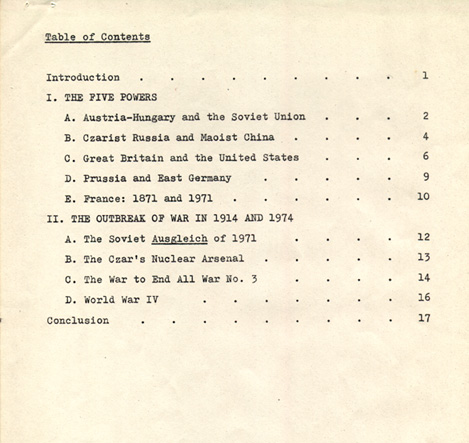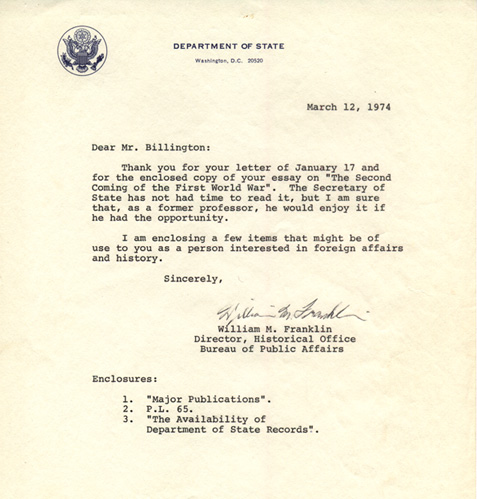In my 1974 essay (table of contents below), I correlated three of the great powers in the post-1815 era with three from the era after 1945. I thought that nineteenth century Austria-Hungary, Imperial Russia, and Great Britain had returned after 1945 as the Soviet Union (USSR), Maoist China, and the United States of America respectively. The last three differed in obvious ways from the first three but what interested me were certain similarities in position and function that I proceeded to describe.
I also forecast that in the post-1945 era West and East Germany would eventually reunify. If Germany then drew closer to the Soviet Union, I thought that France might develop closer ties to Communist China, echoing German and French ties respectively to Austria-Hungary and Imperial Russia in the years before 1914.

With hindsight, I was wrong in three principal respects:
First, I thought that West Germany would lean much farther to the left in order to unite with East Germany, so that a reunified Germany could prop up a declining Soviet Union in the way that Imperial Germany propped up Austria-Hungary. In fact, West Germany did not want to move to the left and align in this way, and eventual reunification did not require it. My forecast about France therefore also did not come true.
My conjecture about Germany followed a trip to Europe at age 17 in 1970, when I visited East Berlin and saw the goose-stepping guards at the Victims of Militarism memorial. This made me wonder if something of old Prussia was still alive and well. I also stood on a street corner when a troop truck full of Russian soldiers my age pulled up. I looked in at them and they looked at me, and their faces didn't seem at all eager for war. I later concluded that the Soviet Union was in trouble.
Second, I thought the Soviet Union would launch a preemptive strike in the near future to prevent Maoist China from developing a nuclear arsenal. I did not know at the time that the moment for this had actually come in 1969, when Washington rejected an invitation from Moscow to support a Soviet strike. As a result, Moscow backed down and war was not on the near horizon.
Finally, because I stopped the second repetition in 1974, I did not project the analogies farther into the future. I also focused on domestic affairs only to the extent that I thought they affected foreign relations. If I had given the second repetition as many years as the first and if I had looked more closely at domestic change:
(1) I could have better predicted the timing of change to the USSR. I dated to the late Soviet period a return of the Ausgleich or compromise in Austria-Hungary that created a deadlock between reformers and hardline oligarchs. However, this change occurred after Austria lost control over the smaller states of Germany and Italy. I should have postponed the second Ausgleich until the Soviet Union had lost control over eastern Europe. My description of deadlock in the late Soviet Union (with hardliners ascendant) was also true of reformers and oligarchs in the Russian Federation that followed. Moscow also never accepted the complete freedom of the western Soviet republics that it let go in 1991. Russia is now trying to reconquer Ukraine, so I think the analogy to Austria-Hungary as an unstable multiethnic state still would have held.
(2) I could have carried forward the domestic evolution of Imperial Russia and by analogy predicted what would happen in Communist China. Just as Tsarist Russia eventually abolished its version of serfdom, I could have expected China at some point to free its peasant majority from what amounted to state serfdom. Imperial Russia then embraced a two-track policy of industrial modernization and political repression. I could have expected China to follow the same two-track policy.
(3) Finally, Communist China's modernization would have also enabled me to locate the return of something equivalent to Imperial Germany. China would have still had the rural majority and autocratic government of late Imperial Russia. But by growing a modern urban sector, China could have been forecast to have someday the ability to possess the military and naval power with which to challenge the United States in the way that Imperial Germany challenged Great Britain.
By giving the period after 1945 the same number of years to unfold as the period after 1815, I could have also called the turning points in 1989 and 2001 (corresponding to 1859 and 1871) exactly, along with a sharpening of great-power tensions after 1890 and 2020.
For the 1974 version of my essay, see here.
For the 2024 version, see here.
Although he did not draw the historical analogies that I did, I was impressed at the time with the Russian dissident Andrei Amalrik, whose 1970 essay predicted the collapse of the USSR in 1984 (he was off by only seven years). Amalrik correctly perceived the deadlock in the Soviet system but he mistakenly thought that a war between Russia and China would occur by the early 1980s. In fact, China moved in a more moderate direction after the mid-1970s, postponing conflict with other great powers to the more distant future.
Back to essay.
Back to main page.
